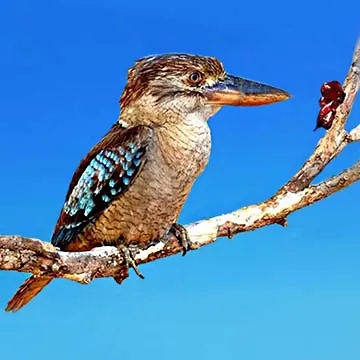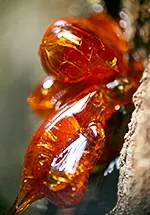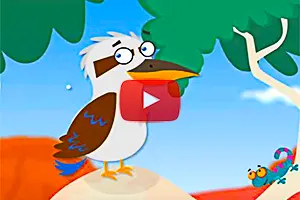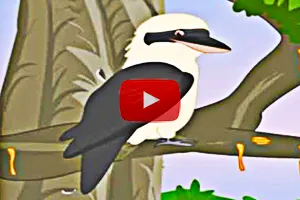Kookaburra Song Kookaburra Sits in the Old Gum Tree

Contents
The Kookaburra Song, also known as Kookaburra Sits In The Old Gum Tree, is a cheerful Australian nursery rhyme about a kookaburra bird perched in a gum tree, laughing, eating gumdrops, and counting all the monkeys around him. Written in 1934 by Marion Sinclair, its playful lyrics, catchy melody, and whimsical imagery have made it a timeless favourite among children and adults around the world.
Kookaburra Song Words
Kookaburra sits in the old gum tree,
Merry merry king of the bush is he.
Laugh, Kookaburra, laugh, Kookaburra,
Gay your life must be!
Kookaburra sits in the old gum tree,
Eating all the gum drops he can see.
Stop Kookaburra, stop Kookaburra
Save some there for me!
Kookaburra sits in the old gum tree,
Counting all the monkeys he can see.
Stop Kookaburra, Kookaburra stop.
That's not a monkey, that's me!
Meaning of the Words in Kookaburra Song
Have you ever wondered what the words in the Kookaburra Song mean? Listed below are some of the words used in the 'Kookaburra Sits in the Old Gum Tree', which may be unfamiliar to some readers.

Photo: Kookaburra bird
Kookaburra – The kookaburra bird is a large Australian kingfisher. It is sometimes also referred to as the Laughing Kookaburra because it makes a sound like a human laughing.
Gum Tree – This is another name for the Eucalyptus tree, which is very common in Australia.
Bush – The people of Australia refer to parts of the country outside the major cities and towns as " the bush". The phrase probably originated because there are lots of bushes and scrub when you go into the Australian countryside.

Photo: Gum drop
Gum Drops – When some types of eucalyptus trees are damaged by insects, they ooze blood-red sap (like humans ooze blood). This sap forms large drops that harden when they dry. The dried sap globules from these trees are called gum drops. You can't eat sap. You would get sick if you did. Actually, kookaburras don't eat them either. Gum drops are also a type of candy. So in this song, it means candy.
Gay –When this song was written in 1932, the word "gay" meant "happy and carefree". Since about 1955, the term has taken a different meaning. Today, the word refers to a homosexual person, or sometimes the word is used by the younger generation to mean "lame" or "stupid".
Monkeys – There are no wild monkeys in Australia. The closest animals that climb trees in Australia are koalas or possums. The word was probably used because it rhymed well.
Listen to the Kookaburra Song
We have hand-picked two delightful versions of the Kookaburra Song for you to enjoy. Simply click on the photo-links below to listen.
Marion Sinclair Wrote the Kookaburra Song
Marion Sinclair wrote Kookaburra Sits in the Old Gum Tree in 1932. She titled the song Kookaburra Sits in an Old Gum Tree, but over time, it evolved into its present names of Kookaburra Song and Kookaburra Sits in the Old Gum Tree.
Marion Sinclair (1896-1988) was born on 9 October 1896 in Werribee, Victoria. She was educated at home until the age of 14 and spent a lonely childhood without much contact with other children. She found comfort in playing the piano and writing her own stories and rhymes. She attended Toorak College between 1911 and 1913. In 1920, she joined Toorak College as a music and drama teacher and involved herself with the school's Girl Guides group. Marion obtained a diploma of Music from the Melbourne University Conservatorium of Music in 1924.
In 1932, Marion Sinclair entered her composition Kookaburra Sits in an Old Gum Tree in a Girl Guides competition for a home-grown Australian song. She won the contest, and her song was sung later that year at a Girl Guides jamboree held in Australia. Visiting guides and scouts liked it so much they took the catchy tune back with them. It soon gained worldwide popularity and was translated into many languages.
Marion left Toorak College in 1943 and worked in many welfare roles, mostly with the YWCA. While not officially taking out copyright, throughout her life, Marion frequently acknowledged ownership of the song and often permitted others to use it. In 1987, she assigned copyright and ownership of all her private records to the Libraries Board of South Australia. Marion Sinclair died on 15 February 1988. The Libraries Board of South Australia sold the copyright to the Kookaburra song to Larrikin Music Publishing Pty Ltd. for $6,100. Larrikin Music was bought by Music Sales Corporation in 1988.
Kookaburra Song Controversy
This little Australian nursery rhyme was recently involved in a significant court case. The legal episode started in 2008 when the Australian Broadcasting Corporation TV show Spicks & Specks asked the question, " What children's song is contained in the song Down Under? " The answer supplied was Kookaburra. Only becoming aware of the similarity when raised by the TV show, Norman Lurie, the managing director of Larrikin Music, which had acquired the copyright for the song in 1988, launched the legal action claiming copyright infringements – namely plagiarism.
On 6 July 2010, the court ruled that the flute riff in the song Down Under was indeed a copyright infringement as "Down Under reproduced a substantial part of Kookaburra". The band was ordered to pay royalties backdated to 2002 and future royalties at 5% to Larrikin Music. (It should be noted that Larrikin acted within the law to protect its copyright). Because of the negative publicity generated by the court case, Larrikin Music, in 2014, changed its name to Happy as Larry.
Is the Kookaburra Song based on an Old Welsh Folk Song?
There are claims that the tune for the Kookaburra Song actually came from a Welsh folk-song " Dacw ti yn eistedd, y 'deryn du". But recent research suggests that there are no known recordings of this Welsh tune before 1989. It has been suggested that the Kookaburra tune was copied instead. Here is a YouTube clip of the Welsh song.
All Rights Reserved. (Last Updated: Jun 06, 2025)


